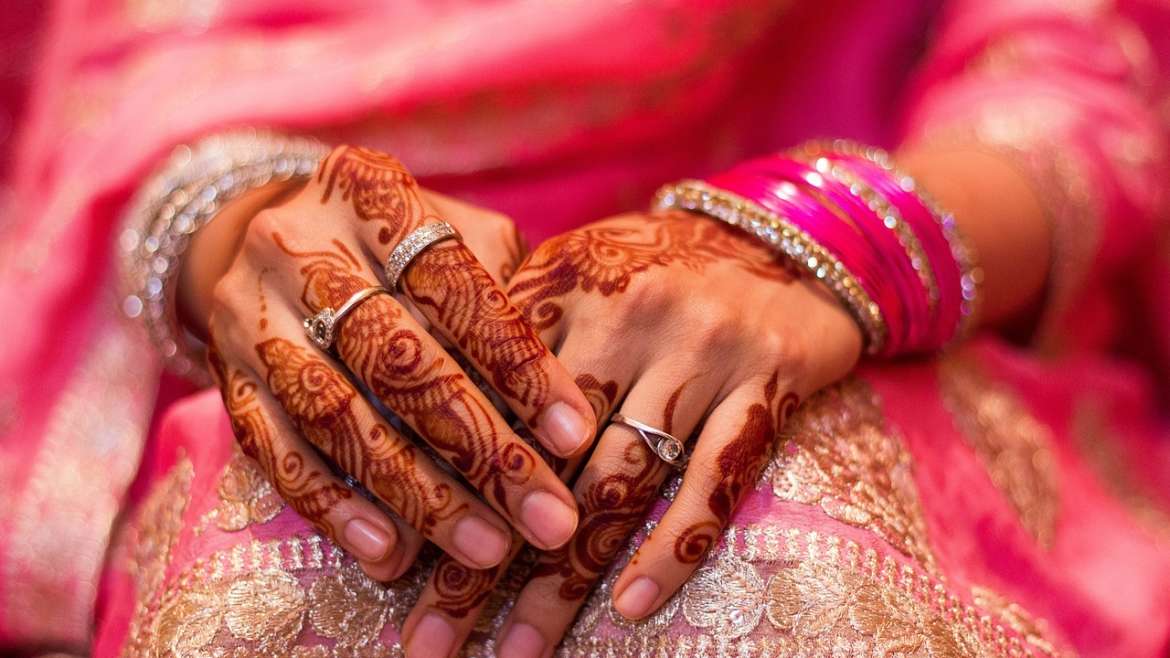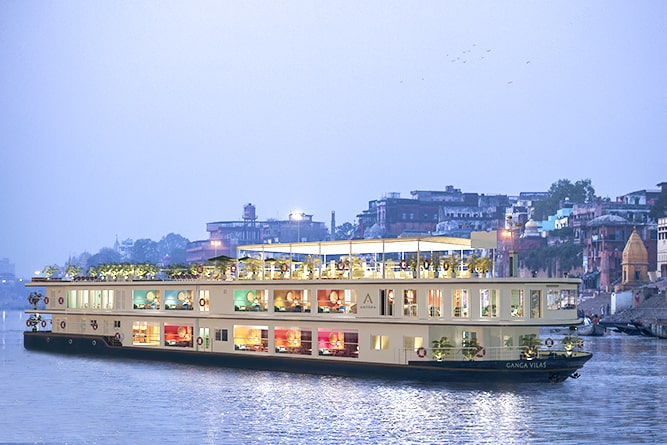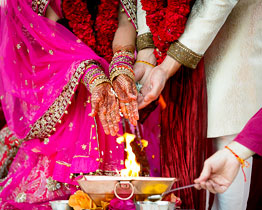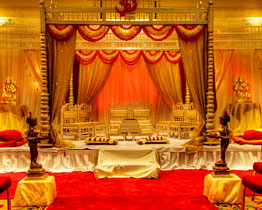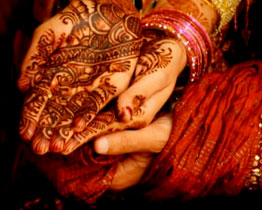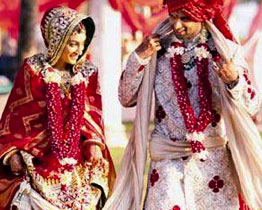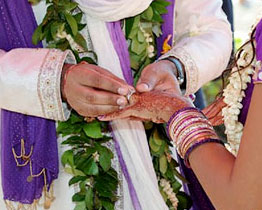Making Moments Into Memories
The one event in your life that ought to be truly glorious is your Wedding. Breaking the monotony of having a conventional wedding, iMEC Planet Wedding planner team is specialised in planning modern, exceptional and chic weddings. We bring a fresh perspective and innovative approach to wedding design, event planning & management, merged with traditional wedding planning and etiquette. We turn your day of love into an unforgettable event and a day you will cherish for the rest of your life.
As destination weddings in Indian Sub-Continent are setting trends in modern times, we have listed the most awe-inspiring wedding destinations in Indian Sub-continent that will leave you love-struck and get you a step closer to your destination wedding.
It seems a lot easier than being done when we say it takes a lot of time and energy in checking everything off that wedding planning checklist and most importantly, deciding the wedding destinations in Indian Sub-Continent.
Since it’s more about two families coming together to celebrate a new beginning of their loved ones, perfect Indian wedding destinations get etched in everyone’s memories for a lifetime. As destination weddings in India are setting trends in modern times, we have listed the most awe-inspiring wedding destinations in Indian Sub-continent that will leave you love-struck and get you a step closer to your destination wedding. Take a look!
REVOLUTIONIZING THE WHEEL OF BESPOKE WEDDING PLANNING
Making a lasting impression by delivering elegance, flair and commitment
350+
No of Weddings
3+
Decades of Experience
50+
Wedding Destinations
100+
Team Members
 North Indian Wedding Traditions
North Indian Wedding TraditionsIndian Weddings with all their grandeur and magnificence have cast its spell on so many foreigners that there are many who consider getting married in India. Consequently wedding tourism in India is increasingly gaining popularity. Apart from the opulence, another striking feature of Indian weddings is their loyalty to customs and traditions. As is the case with other parts of India, North Indian weddings also follow a lot of rituals and customs. North Indian wedding traditions include many rites and rituals performed on the D-day.
In traditional North Indian weddings, the main ceremony takes place at the brides’ home. There are many pre-wedding and post-wedding ceremonies as well. The most important of the former is the Mangni or Sagai or engagement ceremony. On the auspicious day of the wedding, the bride’s father treats the groom to yogurt and honey and graciously welcomes him into the household. One of the most important of North Indian wedding traditions is the exchanging of garlands, commonly referred to as the Jaimala ceremony and is symbolic of accepting one another.
The ceremonial fire or Havan is lit and Agni is invoked to witness the occasion. Fire is regarded as a purifying element in Hindu rites and rituals. The couple then offers sacrifice or Rajaham to the fire. This is typical to North Indian wedding tradtions. The ritual that follows next is the Gath Bandhan, symbolic of eternal ties. Then it is the turn of what is regarded as the most important all North Indian wedding traditions – the Saat Phere or Mangal Phere. The bride and groom circle the fire often holding hands and take vows to be beside each other throughout their lives. Both sets of parents and other elders of the family then bless the newly wedded couple.
North Indian wedding traditions also include putting on the Mangal Sutra as well and application of vermillion on the bride’s head by the groom. These rituals have a deeper symbolic relevance and a certain quaint charm and appeal. It is no wonder then that they enamor even foreigners. If you are one of those who choose to marry following the North Indian wedding traditions, simply avail of any the special wedding tour packages on offer by Indian Holiday. There are many exotic wedding venues in India and a splendid wedding in any of them is sure to remain embedded in your memories forever.
 South Indian Wedding Traditions
South Indian Wedding TraditionsThe Hindu wedding ceremony has a number of rituals and customs, each symbolic of beautiful and noble sentiments. South Indian wedding traditions and ceremonies are no exception. As one enters the place or venue of ceremony of a South Indian wedding, one notice things such as full-grown plantain trees tied to both the gateposts, festoons overhead of mango leaves, and screw-pine petals that never fade, notes of the Nadaswaram, the South Indian Shehnai, Kolam or Rangoli designs at the doorsteps and the like.
On the evening prior to the wedding day, the bridegroom is brought in a procession from a temple in a flower-adorned ride. The bride’s parents escort him to the marriage Mandapam. Nadaswaram band leads the way along the streets. After reaching the marriage hall, there is a formal ceremony of espousal. Ganapati, the God of Initiation is invoked, to keep away all hindrances. There are several presiding gods – the Nandi Devatas. To please them, a leaf-laden branch of the Pipal tree is set up, and 5 married ladies perform a ritual of washing it with milk.
This Puja or worship is followed by a presentation of a dhoti, and a saree to the espousing couple. This is performed to propitiate the 9 astral planets that rule over human destiny. The marriage ceremonies start with the Vratham performed separately by the bride and the groom. For the bride, it means the tying of the holy thread on her wrist that is meant to keep away all evil spirits. From there on, the groom prepares himself for a new chapter in his life as a householder or Grihasta. The days of his bachelorhood are now over and the acceptance of this is all what the Vratham is about.
At the marriage hall, the bride’s father and the bridegroom’s father facing each other, formalize the final betrothal ceremony, as the Vedic priest chants the appropriate hymns in which the names of the bride, the bridegroom, as well as the names of their 3 generations of ancestors, are cited in presence of all the friends, relatives, and guests. The bride and the groom are lifted to the shoulders of their respective uncles, and in that position they exchange flower garlands with each other thrice for a perfect union. Here the exchange of garlands symbolizes their union. It is also symbolic of acceptance of each other by exchanging the very fragrance of the other.
The bride is made to sit on her father’s lap and is given away as a gift by him to the bridegroom. On the girl’s head, a ring made with Kusa, is placed, and over it is placed the Mangal Sutra on the opening of the yoke, and water is poured through the aperture. The bride is then given an auspicious washing, and an elite new Koorai Saree is draped around her, which is done by the sister of the bridegroom.
The bride is made to sit on her father’s lap and is given away as a gift by him to the bridegroom. On the girl’s head, a ring made with Kusa, is placed, and over it is placed the Mangal Sutra on the opening of the yoke, and water is poured through the aperture. The bride is then given an auspicious washing, and an elite new Koorai Saree is draped around her, which is done by the sister of the bridegroom.
Three knots are tied, the first one by the bridegroom, the other two knots by his sister to make the bride a parts of the boy’s family. The groom holds the hand of the bride. Holding the bride’s hand, the bridegroom walks seven steps with her. This is the most important part of the marriage ceremony, and only when they walk seven steps together is the marriage complete. The belief is that when one walks seven steps with another, one becomes the other’s friend.
A vital part of the wedding is the honor paid by the couple to Agni, the fire God. They circle around the fire, and feed it with ghee, and twigs of nine types of trees, as sacrificial firewood. The vapors that arise, are supposed to possess therapeutic, healing and purification properties for the couple. Agni, the most powerful element in the cosmos is deemed as a witness to the marriage.
The bridegroom helps her tread on a grindstone kept on the right side of the fire, holding the bride’s left foot toe. The elders and the invitees shower Akshadai, or rice-grains coated with turmeric and saffron, on the couple, – as approval. Taking with her, fire from the Laaja Homam, the bride leaves her home, and enters the new home of her in-laws. The Vedic hymns sound like mother’s words of advice to her daughter.
The evening of the marriage day is a time to relax and rejoice. The newly married wife calls her husband for play, alluring him through a song. Much to the cheerfulness of one and all gathered there follows list of playful items. During these items, the ladies sing songs poking fun at the bride, the groom and the in-laws. These proceedings bring out many qualities of the bride and the groom, such as sporting spirit, kindness, strength, co-operative nature and the like.
A solution of lime and turmeric powder, is prepared on a plate, and circled around, and thrown away to keep the evil eye at bay. This is done a number of times during the entire wedding ceremony, and also at the end.
 East Indian Wedding Traditions
East Indian Wedding TraditionsHindu weddings are ceremonial feasts laden with symbolic rites and rituals. Despite India’s diversities in language, culture, food and lifestyle, one can observe common threads in many Hindu weddings across the nation. The East Indian wedding traditions mainly include the marriage traditions of West Bengal, Orissa, Assam and other northeastern states of India.
Bengali wedding ceremonies consist of simple but meaningful rituals. There are plenty of interesting Bengali wedding traditions and customs, which enable close friends and relatives to come together and share joyous moments while celebrating the union of two souls.
When the marriage procession of the groom arrives at the entrance of the bride’s residence, all of them are given a hearty welcome with fresh flowers. The Baran Dala is touched to the groom’s forehead by an elderly female relative of the bride, and then to the ground. This gesture stands for a portion of blessing. Then, the groom is offered sweets and sherbet. As the groom gets into the bride’s house or wedding venue, rosewater is sprinkled on him. The Shubho Drishti ritual is performed when the bride and groom first look at each other.
The Mala Badal ceremony is the exchange of flower garlands between the bride and groom along with the chants of mantras. As a part of Saat Paak ritual, the bride has to sit on a low wooden stool called Pidi that is lifted by her brothers. Then, the girl is taken around the groom seven times in circles, which symbolizes their union. During the Sampradhan ritual, the bride’s responsibility is given to the groom by her paternal or maternal uncle. After this, the Saptapadi ritual takes place.
The Basar Ghar ceremony is a custom in which the newly weds are given a warm welcome in the bride’s house and are served a delectable dinner. During the Bashi Biye ritual, the next morning after the wedding, the groom applies vermilion on his wife’s forehead. Then the newly married couple visits the Mandap, and worship the Sun God.
During the Bidaai Ceremony the newly weds leave for their home, after being blessed by all the elders. The Bou Baran ritual is performed to give an affectionate welcome to the newly weds in the groom’s house. The wife of the groom’s elder brother carries a plate containing Alta and milk and places it under the bride’s feet. The bride then has to enter the house escorted by her sister-in-law. The imprints of her feet on the floor of the house are preserved for a while. She also receives blessings by all the members of the house. In the Bou Bhat ceremony, the bride serves the members of the house and eats her first meal in her husband’s house. A reception party hosted by the groom’s family mostly takes place in the evening.
Assamese wedding ceremony is simple but chic at the same time. The melody of the gentle wedding song ‘biya naam” features the exclusivity of the wedding. The wedding day begins with the performance of the Bathing custom. The bride and groom’s mother visit the nearby river with a vessel and collect holy water. This water is afterwards used for the ceremonial bath of the bride and groom, which takes place in their respective houses.
In the Assamese community, the wedding reception party is held before the marriage ceremony when delicious food is served to the guests. Fish and meat are the main food items of the wedding reception menu. After the arrival of the groom, the bride’s family indulges in fun time activities. The bridegroom’s marriage procession is not allowed to enter the bride’s home, until they pay a large sum of money.
During the wedding ceremony the bride’s mother welcomes her future son-in-law and the bride’s younger sister washes the groom’s feet. Then, the bride’s brother lifts him up and takes him to the marriage hall. In a traditional Assamese wedding, the bridegroom dresses up in dhoti and kurta, with a silk shawl wrapped crosswise on his shoulder. The bride is given Panch-Amrit that is a mixture of ghee, curd, sugar, honey and raw milk to eat. Then the bride makes a grand entry on the shoulders of her maternal uncles.
The wedding ceremony takes place in front of the holy fire. The couple exchanges their flower garlands and takes vows amid the chanting of mantras. Conch shells are blown which mark the celebration. The bridegroom applies vermillion on his wife’s forehead. Afterwards the friends and relatives bless the newly weds. The newly married couple then goes to their house, where they are received warmly and the bridegroom’s mother performs the traditional Aarti.
Oriya wedding ceremonies are relatively the same as other Hindu weddings, with some minor difference in the customs and traditions. An exceptional feature about the Oriya wedding ceremony is that the mother of the bridegroom does not take part in it. During the Kanya Daan ceremony, the bride’s father gives his daughter’s hand to the bridegroom and he in turn promises that he will take care of her. In the Haatha Ghanti Custom the bride and the groom take seven rounds around the sacred fire, along with the chant of mantras and shlokas.
 West Indian Wedding Traditions
West Indian Wedding TraditionsAn Indian wedding involves a lot of fun, frolic, celebrations, rituals and holy ceremonies. Indian wedding traditions are gaining popularity across the length and breadth of the world. In fact, many foreigners seek to get married in India by indulging in Indian wedding traditions. Owing to India’s rich cultural diversity, wedding traditions differ slightly according to the region. The West Indian wedding traditions mainly include the traditions of Maharashtrian, Gujarati and Marwari weddings.
The Maharashtrian wedding ceremony exhibits wonderful magnificence. Usually, marriages among the Maharashtrians take place in the morning. An auspicious time or Muhurat is chosen, which is known as the Goraj Muhurat. During the ceremony at the time of Shubh Muhurat, the girl’s maternal uncle escorts her to the Mandap. The girl and boy are not allowed to see each other for some time. Then the shlokas are chanted and this is followed by the removal of Antarpaat. People shower Akshata (unbroken rice) on the couple. The garlands are then exchanged between the bride and groom and the couple takes Saat Pheras or Mangal Pheras in front of the holy fire.
After the marriage ceremony, Laxmi Narayan puja is conducted, in which the bride and groom are worshipped as Goddess Lakshmi and Lord Narayan. The girl’s hand is formally given to the groom in the ceremony known as Jhal Phirawne or Kanya Daan. There has been a custom among the Maharashtrians to change the name of the girl after marriage. This ceremony, if held is usually performed the groom’s house. The reception party is hosted on the night of marriage, for which a special feast is prepared.
Gujarati wedding ceremonies begin with offering prayers to Lord Ganesha and seeking his blessings. Like any other traditional Indian wedding, Mehndi and Sangeet ceremonies follow it. Jaimala or flower garlands are exchanged between the bride and the groom twice. First time, the groom is on a higher platform than the bride, while, the second time, they are at an equal level. In the Madhuparka ceremony, the groom’s feet are washed and he is given honey and milk to drink. While the ceremony is on, the bride’s sisters attempt to steal the groom’s shoes, known as ‘Juta Churai’. The groom who seeks to have his shoes back handsomely rewards them for this later.
One of the most important wedding rituals is Kanya Daan in which the bride’s father washes the groom’s feet and gives his daughter’s hand to him hoping that he will take good care of her. The bride is considered to be a form of Goddess Laxmi and the bridegroom is considered to be Lord Narayan. Hasta Milap ceremony involves the tying of the groom’s shawl to the bride’s sari. The tying of knot and the joined hands of the couple are emblematic of the meeting of the two hearts and souls. The family and relatives sprinkle rose petals and rice grains on them.
Pheras come next and are rounds that the couple takes around the sacred fire, as the priest chants mantras. Saptapadi are the seven steps that the married couple walks together and takes seven vows. Then, the couple seeks the blessings of their parents and other elders. This marks the conclusion of the wedding ceremony and is followed by a reception party. In the Vidaai ceremony, the bride bids farewell to her parents, friends and relatives and both of them part moving towards their home, with a new life awaiting them.
During the Marwari Wedding Ceremony, the Baraat has only male members. The Rajput groom generally wears a gold achkan and churidar or jodhpurs with an orange turban. The groom’s marriage procession is conducted royally. There is no street dancing by the Baraatis. Everyone including the bridegroom rides an elephant or a horse and also carries swords in their hands symbolic of valor.
When the marriage procession of the groom arrives at the bride’s home, the ladies take the bridegroom inside. His mother-in-law gives him a warm welcome by performing the traditional Aarti.
During the wedding ceremony the groom is escorted to the Mandap and is usually accompanied by only one married male relative and his younger brother or a younger male cousin. The bride generally has to cover her face with a long veil. The female members of the house mainly attend the wedding ceremony.
In the Bidaai ceremony, the bride bids adieu to her family, friends and close relatives. At the time of Bidaai, a coconut is kept under the wheel of the car. When the newly weds reach their house, the bride is received by the groom’s family. This custom is known as Griha Pravesh.

Weddings in Nepal generally take place in tender age in Nepal. It is everyday for boys and ladies to be married for the duration of their teenagers but in few instances in very younger ages. This symbolizes that they are now husband and wife. We assist you in identifying on which tunes to play and that can consist of all the Nepali traditional music as well as the bride groom’s favored ones with beautiful dancing numbers. The marriage venue is decorated through colorful paper plants and twinkling lights.
These factors may also encompass caste, religion, ethnicity and also the consideration of ties between families in an effort to construct allegiances. It is necessary that arranged marriage and compelled marriage in Nepal are not confused. In a village the couple reaches the marriage venue on horses or baskets, while in a town marriage the couple arrives at the venue in a decorated car. These weddings are totally diverse from the own subculture village wedding. Interested Nepali way to wedding ceremony and Treks Himalaya organize wedding program.
Music is an integral part of marriage. Nepalese bride dresses in the bridal shade of red and is bejeweled with gold and treasured gems. Traditionally, the bride and groom are escorted to the marriage venue. This crimson coloration on the woman’s forehead differentiates whether she is married or not. The bride and groom with the aid of subculture are continually carried both in a wood casket or by using horse. The wedding technique normally starts offevolved with an association of a boy and a female with related backgrounds; often with the help of a priest who are properly known as matchmaker.
One of the essential occasions in our regular wedding ceremony is that the groom puts a pinch of red-coloured powder on the bride’s forehead. It is now not everyday exercise for families in Nepal who are arrange marriages to force their progeny to marry any person that they do now not want to marry. As point out earlier, wedding society in Nepal, according to cultural groups and caste we have attempt to cowl all in most cases all numerous tradition, very simple for very wealthy in society.
Gathering takes vicinity between the parents of the two families. In an organised marriage, it is the mother and father who select their kid’s partners. One additional be aware concerning the arranged marriage even though the parents pick out the individuals, the teens are commonly given a voice to receive or decline the match.
There are instances, however, of a couple not seeing every other for the first time until the ceremony begins. In a love marriage, it is the boy and the lady who pick their mate. The offspring are also consulted and it is necessary that they consent to the marriage. The bride after being passed over to the groom with the aid of her mother and father will then tour to the groom’s village to grow to be a member of his family’s household. Nepal Wedding Planners shall assist you right from choosing the birthday celebration venue, deciding on a brass band party, enjoyable the visitor with true food, tune and growing the universal ambience.
 Marriage is legal and social union relationship between a bride and bridegroom as a wife and husband and also a traditional wedding ceremony in Nepal. Therefore it is a formal relation of a man and women. In Nepal there are people with different caste, culture, norms and values. They have their own marriage culture and practice different types of marriage system according to their caste.
Marriage is legal and social union relationship between a bride and bridegroom as a wife and husband and also a traditional wedding ceremony in Nepal. Therefore it is a formal relation of a man and women. In Nepal there are people with different caste, culture, norms and values. They have their own marriage culture and practice different types of marriage system according to their caste.
In Nepal there are specially two types of marriage one is arranged marriage in which parents choose a partner for their son/daughter, and other one is love marriage .
In the context of Nepal mostly traditional marriage system that is arrange marriage is very common. In arrange marriage boy’s parents goes to the girl’s house and talk about all family back ground and if both sides are agree then they will fix for marriage. Then astrologers decide an auspicious date which falls in the special months of a year. Hindu marriage is performed in accordance with the Vedas. Vedas are thousands of years old holy scriptures of Hindu religious that is considered to own the essence of Hinduism. During the ceremony, marriage venue is decorated with colorful flowers and lights. Bridal color is red and she is beautifully makeup with much jewelry and decorated net covering her head.
Traditionally, the bride and groom are being carried to the wedding ceremony. In a village this may be in a basket or by horse; but at city wedding transportation is move likely to be by a parade of cars. Music is an essential part of marriages the tradition music in the form of Panche baja and folk songs and dance is still popular among people as on this sacred day they believe that playing traditional music strengthens the nuptial knot, pleases God and not least of its entire make all environment charming and pleasant.
 In Nepal, 90% of marriages are still arranged.
In Nepal, 90% of marriages are still arranged.
Below are the steps that needs to be taken care while having arrange marriage in Nepal or in Indian sub-continent.
1) The parent will choose the spouse for their daughters/sons with qualities like:
Similar caste
Similar family reputation
Girls/guy’s qualification (study, job)
Girl/guy’s qualities (look, hobbies, background)
Cultural and/or religious understanding
2) The bride and bridegroom normally never set eyes on each other before their wedding day.
3) The bride and bridegroom are having sex for the first time during the wedding night. In Nepal, no dating, no sex before marriage, no divorce.
4) The bride must be a virgin or she will be returned to her family even the wedding ceremony took place. If she is returned, she won’t get a chance for the second marriage and she will be abandoned from the society. So, can be very sure here that most of the unmarried “good girl” are still virgin if they not yet married. And, she most probably only has one man – her husband in her entire life.
5) Once married, the bride is belonged to the bridegroom and his family. She can never return home and stay with her parent any more. Even she is treated badly. Thus, all women in Nepal will try their best to please her husband and the family so they can have good and happy life.
6) The couples must be from similar caste. The caste system still exist here in Nepal.
7) The bride’ family needs to prepare dowry. Dowry is the wealth transferred from the bride’s family to the groom or his family. If the bride’ family did not pay the dowry, the bride might be returned to her home, and will be rejected/bullied/beaten by the bridegroom’s family.
 Weddings in Nepal are momentous occasions which are often planned years in advance of the wedding itself. In line with other festivals in Nepal, weddings are colourful and beautiful events.
Weddings in Nepal are momentous occasions which are often planned years in advance of the wedding itself. In line with other festivals in Nepal, weddings are colourful and beautiful events.
Traditionally, weddings in Nepal are arranged by the respective families. It is not uncommon for matches to be decided when the two individuals are still children. However, child marriages in Nepal – as with the majority of countries the rest of the world, are illegal and the couple therefore wait until adulthood to complete their marriage rites. Traditionally families in Nepal consider a number of factors before arranging the marriage. These factors may include caste (traditionally marriages do not happen across castes), religion, ethnicity and also the consideration of ties between families in an effort to build allegiances.
It is important that arranged marriage and forced marriage in Nepal are not confused. It is not normal practice for families in Nepal who are arranging marriages to force their offspring to marry someone that they do not wish to marry. The offspring are also consulted and it is important that they consent to the marriage.
It is worth noting however, that there is a slow shift in Nepal away from arranged marriages to ‘love’ marriages i.e. individuals now have more freedom in Nepal to chose who they wish to marry without family interference. There is also a shift in Nepal towards marriage across castes (which traditionally was strongly resisted) and across ethnic groups.
Hindu weddings and marriages in Nepal are colourful occasions and travellers to Nepal may be fortunate enough to witness either the wedding itself or, at least to witness the wedding parties making the journey to the bride’s house. These journeys can sometimes take a number of days to complete due to the distance between the groom and bride’s home. Hindu marriages in Nepal are often arranged with the assistance of a priest, who analyses the horoscopes of the couple to ensure that they are compatible and they typically take place during the days of selected months.
Buddhist weddings in Nepal are often quieter occasions, with a focus on ceremonial displays. The weddings are usually extremely large, sometimes encompassing whole villages and large numbers of extended family.
Sherpa weddings and marriages differ to Hindu and Buddhist weddings quite considerably. Sometimes the marriage rites for the couple are completed years in advance of the actual wedding ceremony and consequently, the couple may even have their children attend the wedding!
For a marriage in Nepal to be legally-binding, the couple must meet the Government of Nepal’s requirements. The legal marrying age in Nepal is 20 years old for men and 20 years old for women. The authorities responsible for registering marriages involving foreigners are the Chief District Administrative Office for each district, popularly known as “CDO office.” In Kathmandu, the CDO office is located in Babar Mahal.
Registering your marriage at the CDO
To apply for a Government of Nepal-issued marriage certificate, you must submit the Affidavit of Eligibility to Marry with other required papers at the CDO office. The CDO also requires evidence of your nationality, photographs, and a nominal processing fee. After you apply, the CDO will check your legal status in Nepal with various government offices. This process may take some weeks. After the CDO processes your application, they will issue a marriage certificate, which is usually written in both Nepali and English.
What happens in a typical marriage !?
Wedding customs in Nepal vary according to ethnic groups and castes. Nepal, have different kinds of wedding ceremonies because of varieties of cast and creeds. Weddings in the metropolitans have parades or car for the wedding processions; full fledged band instruments such as trumpets and trombones, ferry lights all over the house which is naturally more expenses. These weddings are completely different from the traditional remote village weddings. They are very simple for very rich in culture.
Wedding in Nepal is a multi day event, which may engross an entire village. In its essence, it reveals the very strong social and communal values of the Nepali people. Few things in Nepali culture take precedence over a wedding and most people treat the time as the opportunity of a lifetime and a time to hold back and celebrate with varieties of foods, fun and dancing.
Weddings generally take place in tender age in Nepal. It is normal for boys and girls to be married during their teens but in few cases in very young ages. The wedding procedure usually begins with an arrangement of a boy and a girl with comparable backgrounds; often with the help of a priest who are well know as matchmaker. The meeting takes place between the parents of the two families. In an arranged marriage, it is the parents who choose their children’s partners. One additional note concerning the arranged marriage: even though the parents choose the individuals, the children are commonly given a voice to accept or decline the match. There are instances, however, of a couple not seeing each other for the first time until the ceremony begins. In a love marriage, it is the boy and the girl who choose their mate. Today, both types can be found throughout the country but it is the arranged marriage that predominates.
However, the love marriage method has been gaining much acceptance over the years perhaps due to the influence of western culture and more over with the drastic develop in media. Eloping may occur between couples that are not thought to be a suitable match in case of different castes & tribes.
Castes are in many ways an extended family. And there are cultural rules that dictate that one must marry into the same caste, but not the same family. There are many small villages today that are predominantly one family. Therefore it is common that a one must look to neighboring villages to marry. This explains why most village marriages are a marriage between one person from one village and the other from another village sometimes days apart. It also explains why marriages last many days as logistics and travel prevent a single day event.
After the initial marriage arrangement takes place, the wedding begins with a gathering of the traveling party at the groom’s house. Celebrations are made and rituals are performed with the local priest and the party then travels to the bride’s village with the procession… This party particularly consists of males only. Once the procession reaches the bride’s village, the groom’s family gamble, drink while the priest performs the ceremony followed by a big feast.
One of the important events in our traditional wedding is that the groom puts a pinch of red-colored powder on the bride’s forehead. This symbolizes that they are now husband and wife. This red color on the woman’s forehead differentiates whether she is married or not. The bride and groom by tradition are always carried either in a wooden casket or by horse (if financially feasible). The bride after being handed over to the groom by her parents will then travel to the groom’s village to become a member of his family’s household.
The Nepali way of life is completely different in comparison to the West. The inheritance goes to son if one and will be divided in to equal part if there are more. The married couples almost always live with the groom’s parents.
Traditionally the couple will either inherit the parent’s land and house or eventually build their own house when feasible.
The ceremony is a very serious affair for the two young people. The bride is dressed in red, which is the color for marriage. Often, she sheds tear as the time to leave approaches. This may be a true feeling of apprehension of leaving the home and family or it may be just a traditional requisite. But many young girls cannot wait to leave the boredom of their life and look forward to having a family of their own.
As we have seen the different way of wedding such as wedding in the air during sky diving, under water wedding in ocean during scuba diving, wedding in the highest peak of the world, Mt. Everest during expedition any many more unique ways to cherish the moment for lifetime. The traditional Nepali wedding is one of those experiences to gather. As mentioned earlier, wedding customs in Nepal differ according to ethnic groups and castes.
It is believed that Hindu way of marriage lasts long. Once they are married they are married for eternity or let’s say many lives. If you have girl friend or boy friend and you are planning getting married, why not marry in Nepal? If you are interested getting married in Nepal or doing volunteering in a marriage ceremony please write us. We are here to provide you such opportunities.
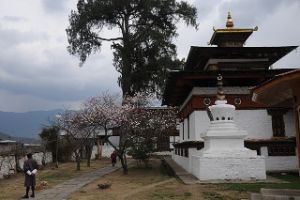 Bhutanese wedding is profound experience and commemorates the celestial union of mind, body and soul of two people. More than just a simple exchange of vows and rings, it entails conducting, set of religious rituals by monks as per Buddhist norms. This rituals signifies the important of bond between partners and importantly bestows upon them the protecting and blessing of Gurus and sentient beings, for a life time of love and happiness.
Bhutanese wedding is profound experience and commemorates the celestial union of mind, body and soul of two people. More than just a simple exchange of vows and rings, it entails conducting, set of religious rituals by monks as per Buddhist norms. This rituals signifies the important of bond between partners and importantly bestows upon them the protecting and blessing of Gurus and sentient beings, for a life time of love and happiness.
The wedding is purely ceremonial and takes place either at Kyichu Monastery or Druk Choeding temple (Paro – Subjected to availability). Build in 7th century, the Kyichu Monastery is one of the oldest and most sacred pilgrimage site for Bhutanese. The temple is a hallmark of arrival of Buddhism in Bhutan and is one of the 108 temples, built in a day by Tibetan king Songtsen Gampo to subdue the deceitful ogress.
The Druk Choeding temple was consecrated in 1522 by a prince abbot, Ngawang Chhogyel. The temple features the sacred statue of Jampa (Future Buddha) along with protector deity of Bhutan, Aum Gyenyen. The wedding will include the following rituals administered by monk.
The Kingdom of Bhutan is a small, remote country tucked away in the Himalayas and surrounded by India in the south and the Tibet Autonomous Region of China in the North. For a country of its size, Bhutan is blessed with diverse terrains, flora, fauna, and even climates. In fact, if you were to drive across the country, you would experience three very different climates — alpine, tropical and sub-tropical! If you’ve never visited Bhutan, you’ll be in for a treat, for the country plays home to gushing rivers, mountains, Buddhist temples of historic importance and a host of colourful festivals. Bhutan has a small population and the country remains unspoiled even to this day. Its people, a hospitable and honest lot, give the country its longstanding reputation for being one of the world’s happiest countries.
In fact, even first-timers to Bhutan know this one fact about the country: Bhutan’s unique idea of Gross National Happiness (GNH) measures the country’s progress and economic output together with the spiritual and cultural growth of its citizens. As remote as the beautiful Himalayan kingdom sounds, it really is quite accessible and that’s the reason for Bhutan’s popularity as a wedding destination, especially among those who want to exchange vows in the midst of nature and with a spectacular landscape for a backdrop.
Bhutan’s pristine beauty has much to do with the fact that the country only opened up to tourism as recently as 1974. Yet, today you’ll find luxury hotels in Bhutan that cater to every whim and fancy of the well-heeled traveller. Accommodation ranges from the luxurious Taj Tashi to a good number of luxury lodges, all of which preserve the natural beauty and rustic feel of the surroundings. They also offer the best in both local and international cuisines. Well equipped to handle weddings in tandem with your destination wedding planner, these top-notch forms of accommodation making planning a destination wedding in Bhutan that much easier.
It also helps to know that connectivity to Bhutan, although limited, is still a breeze thanks to the national airline Druk Air. You can also be rest assured that your guests will always have something to do — whether it’s sightseeing, trekking or simply just kicking back and relaxing — for the duration of your destination wedding. Now that you’ve read a fair bit about this stunning destination, you can sit back and dream up your fairy-tale wedding in Bhutan.
Bhutan’s cities and towns
Paro houses the country’s international airport, but it is also home to the Dungtse Lhakhang, a 15-the century temple, as well as the majestic Ugyen Perli Palace. Bhutan’s most famous attraction perched on a cliff, the Taktsang Palphug Monastery, or better known as Tiger’s Nest, is accessible via a trek from Paro that’s well worth your time and energy.
Once at Thimphu, the largest city and capital of Bhutan, you won’t want to leave. There’s the Clock Tower Square surrounded by quaint shops and restaurants, and the Motithang Takin Preserve, home to Bhutan’s national animal — the takin. Nature doesn’t take a backseat here too. Now that’s good enough reason to host your destination wedding in Thimphu!
 Bhutanese Traditional Wedding & Marriage Customs
Bhutanese Traditional Wedding & Marriage CustomsA Bhutan wedding ceremony is a lifetime event of each Bhutanese people may differentiate themselves from others by celebrating their own unique traditional wedding parties. As Bhutan is greatly influenced by the traditions of Buddhism and still preserve the traditional ways of life, this happiest country holds a very distinctive tradition in Bhutan marriage.
For Bhutanese people, the wedding ceremony is not a simple exchange of vows and rings but a whole set of religious rituals performed by Buddhist monks and lamas, which is believed to tie the bond between husband and wife as well as bless the couples a lifetime of love and happiness. Keep scrolling down for better insight into the most magical things in the Bhutanese wedding.
Bhutanese Traditional Wedding Rituals
Occasionally, the wedding would take place either in Kyichu Monastery or Druk Choeding temple on an auspicious day according to Bhutanese calendar and is followed by a number of rites made by Buddhist Monks here.
Lhabsang
Early on the chosen auspicious day of the wedding, the monks chant the mantras while burning the incense and making offerings to the local deities. This ritual is performed outside the temple and prior to the arrival of the bride and groom. It is a general belief that if local deities are pleased, the ceremony would go smoothly and successfully and the blessings of love and happiness would come true to the ones seeking for them. That is the reason why chanting incense and making offerings to the deities as a way to seek for deities’ approval are indispensable rituals of each ceremony in Bhutan.
Butter Lamp
Upon the arrival of the groom and the bride, the butter lamps would be lit up after 6 times prostration of the couples, 3 times at the Head Lama or Rimpoche and 3 times at the main altar. It is believed that the lighting of a butter lamp not only lights up the house of God but also lights up one’s own life.
Thrisor
After the arrival of the bride and groom, the monk and the Head lama would perform Thrisor service. This purification and cleaning ritual is believed to cleanse the people’s body, speech, mind, soul and more importantly all the sins.
Changphoed
Changphoed ritual is the offering of locally grown brew or Ara to the deities. After the offering, the remaining brew would be served and shared by the groom and bride in the same phoob – a traditional wooden bowl. This ritual signifies the bond that the husband and wife will share for the rest of their lives. The ritual is followed by the exchange of wedding rings.
Exchange of Ring
The exchange of wedding rings is done in every Bhutan wedding ceremony in the world and the meaning of the ritual is to bind the groom and bride forever.
Tsepamey Choko
Tsepamey is the name of the God of longevity and the ritual goes with the blessings to the Bride and Groom for a life-long happy marriage. This ritual is performed by the Head Lama.
Zhugdrey Phunsum Tshogpa
The food-sharing ritual or Zhungdrey takes place during the whole process of the ceremony in a fixed order. First, the fruits and food are served to the local deities, then to God and eventually to the people gathering at the ceremony. Typically, served fruits are oranges which are considered to be attractive, delicious with intact flesh inside, representing the close bond between the couples and ensuring eternal happiness. Note that the fruits served in the ceremony should not be refused nor wasted since it is believed to be improper to behave that way.
Dhar Naynga
Here we come to the last part of the ceremony with the presentation of Dhar Nyanga – symbolic five-color scarves. The ceremony will end with the offering of the scarves to the groom and the bride given along with good wishes for a prosperous, happy and fulfilling married life.
 Bhutanese Royal Wedding
Bhutanese Royal WeddingAs Bhutan is a country under the great influence of Buddhism and traditional lifestyle, the Bhutanese royal wedding is also held in a very Bhutanese way.
The main ceremony takes place in the second oldest and largest dzong in Bhutan, Punakha Dzong, meaning Palace of Great Happiness and Bliss. The wedding attire also features the rich in Bhutanese tradition. Not being assimilated by the Western weddings of luxurious modern wedding dresses and suits, royals still preserve Bhutanese customs by wearing traditional costumes.
The bride puts on a national dress for Bhutanese women, Kira – a raw silk hand-woven traditional dress while the groom wears traditional yellow silk gho – national attire for men. Furthermore, the whole ceremony is organized under the conventional Buddhist rituals and the main organizers are the monks and lamas at the Punakha Dzong.
 Arranged Marriage in Bhutan
Arranged Marriage in BhutanIn contemporary Bhutan, marriages based on family ties have been replaced by marriages based on mutual affection. From the twentieth century, partners have the freedom to arrange their marriage by themselves with no restriction from traditional customs.
Child Marriage in Bhutan
The minimum age for marriage in modern Bhutan society is sixteen for women and twenty-one for men. Child marriage practice in Bhutan has been restricted and gradually abolished in accordance with the modernization of Bhutan.
Interethnic Marriage in Bhutan
Interethnic marriages, previously being forbidden, have been encouraged greatly in modern days; however, intercultural marriages or marriages of foreigners to Bhutanese citizens have been deprecated bylaws and foreign spouses will not be entitled citizenship or citizen privilege. So, if you enjoy a Bhutan vacation and fall in love with a lady, just persuade her to go with you to your country and, of course, you must have the agreement from her family. I think 90% is impossible but just try if you really love her and want to make a Bhutanese lady your wife.
Polyandry Marriage in Bhutan
The custom of polyandry was eliminated entirely in modern days of Bhutan; and polygamy, though being restricted, was still in existence here and there. The law in the 1990s allows men to have as many as three wives as long as they can be able to get the first wife’s permission. The law also supports the wives in the mission of seeking for divorce or alimony if there appears any disapproval about polygamy practice.
The Home of Newlyweds
The home of newlyweds was determined by the greatness of the need for supplemental labor that each parental party desired. If the groom’s family had an insufficient labor force for farming, the bride would come to join the groom’s family, and vice versa. If both families had an adequate number of labors, the spouses might choose to set up their own home.
Marriage in Tibet: The pure soul bonding and a lifelong commitment
Like many other cultures, the institution of marriage in Tibet has possessed its own uniqueness in terms of sacredness in bonding and commitment. Although the marriage institution has undergone series of changes throughout the centuries, the root institution has remained almost the same. We will discuss in detail about typical wedding ceremony taking place these days in Lhasa.
 Before getting married, it is always consider essential for the spouses to consult an astrologist to match the zodiac compatibility of spouses. The compatibility of zodiac is followed by checking the compatibility of Elements of the spouses.
Before getting married, it is always consider essential for the spouses to consult an astrologist to match the zodiac compatibility of spouses. The compatibility of zodiac is followed by checking the compatibility of Elements of the spouses.
The five elements are Earth, Water, Fire, Wood and Iron. The basic compatibility theory should be as below:
Fire and Water (Not compatible)
Water and Iron (Not compatible)
Earth and Water (Extremely compatible)
Wood and Water (Good Compatibility)
If the spouses Zodiac and Elements are compatible, it is then followed by choosing a good date (according to the Tibetan Calendar) on which the wedding ceremony should take place by consulting a Tibetan astrologist. On the first day of the wedding, it is custom for the bride to wait at her home to get pick up by the groom and together they head toward to the groom’s home to start the actual ceremony. The groom’s home will be beautifully decorated. The barley laid on the gate symbolizing the harvest she is bringing into the family. Lamas are often invited to recite mantras on the wedding days to bless the newly wed in their life long journey.
The style of wedding ceremony can also be differed base on the geography. The way of celebration in Kham region is different from those of Amdo region. In Lhasa, the wedding is about 2 days ceremony however there are villages in Tibet celebration the weeding for about 7 days. The Conventional Tibetan society is more of adopting arrange marriage however due to socio-economic changes, it is changing and there are more number of adult going for love marriage.
The typical Tibetan wedding ceremony is characterized by having both the spouses sitting together with their families in Tibetan traditional costumes. The sitting arrangement should be as below:
Bride Groom
Bride
Bride Groom’s Father
Bride’s Father
Bride Groom’s Mother
Bride’s Mother
It is accustomed to have peach, Ginseng Fruits mixed with Rice (Dro Ma Dae Sil) and Butter tea placed on the table in front of them to symbolize good wishes on the special occasion. While sitting in the wedding hall, Monks are invited to recite Mon Tsik (words of good wishes) and Tibetan opera will be performed. It is then followed by offering of Khadak (a white ceremonial scarf made of silk). Khadak will be first offered to the God and then to the spouses and family members accordingly.
It is accustomed to say a word of good wishes like Tashi Delek when offering Khadak. In a typical wedding ceremony, it is required to arrange 2 servants for the spouses who will feed droma Dae Sil (Ginseng Fruits mixed with Rice) to the spouses to bring about good wishes to them.
There are few essential materials to be made ready on the wedding day to symbolize good wishes:
1. A bucket of water with Khadak circulated around it. The water bucket should have to three pieces of butter (Yer Sil) pinched on it to symbolize prosperity of the family.
2. A sack full of cow dung to bring about warmth in the family.
3. A Flag pole (Da Dhar) need to be installed in order to wish the newly wed success in their life journey together. While installing, Tibetan opera will be performed (Namthar). Family members and relatives are required to stand in line while installing the flag pole. It is then followed by a traditional activity called So So (throwing of Tsampa in the air). While throwing Tsampa in the air, it is accustomed to say the word SO thrice followed by KYI KYI SO LHA GYAL LO and then throw the handful of Tsampa in the air. Shrubs (SANG) and incenses are required to burn to bless the newly wed couple. These traditional activities should be performed before the sun set.
4. It is accustomed to have Si Pae Khor Lo (Wheel of Life) to bring about prosperity in the family.
The wedding ceremony ends by performing Gor Shay (Tibetan traditional circled dance) and after which everyone will be occupied by involving in different traditional games like SHO, Carom board etc.
Tibetan Marriage Customs, Wedding Ceremony in Tibet
Tibetan is a minority with unique culture in China. Tibetan marriage customs are also special. Wedding ceremony in Tibet is also different in different regions of Tibet.
 Proposal in Tibetan Marriage Customs
Proposal in Tibetan Marriage Customs
Proposal is the first step of marriage. Traditionally, if a man is interested in a lady, he will seek her age, date of birth and her zodiac attribute (i.e mouse, ox, tiger, rabbit, dragon, snake, horse, sheep, monkey, chicken, dog or pig). With all the information on hand, he will consult an astrologist to check if her attributes are compatible with his. If both zodiac matched, the fellow’s family will choose an auspicious day and get a matchmaker to visit the girl’s family for the formal proposal, with gifts such as khatag, yak butter tea, barley wine and other gifts. If her family agrees, they will accept the gifts. Nowadays, freedom of choosing spouse is also prevail in Tibet.
Engagement in Tibetan Marriage Customs
If both sides agree with the marriage, they will choose another auspicious day to sign an engagement. The ceremony will be held at the lady’s house and should be participated by representatives of both families and the chief witnesses. On that particular day, the man’s family has to send Khatag and other gifts to every member of the lady’s family. Contents of the engagement are more about mutual respect and love, showing filial piety for elders, good morality or inheriting fortune in future, etc. After the witnesses check the duplicate betrothal contracts, they will sign the contracts with the seals of the two families and pass them to both sides. Finally the lady’s family will hold a banquet to celebrate the occasion. At the end of the banquet, each guest will be presented with Khatag upon leaving.
Tibetan Wedding Ceremony
Before the wedding, another auspicious day will be chosen for the wedding ceremony by the groom’s family. On previous day of wedding ceremony, the groom’s side sent a suit of beautiful clothing and a hair ornament wrapped by silk to the bride for wearing. On wedding day, the groom’s side will find a man with good status to take a group of people and colorful arrows decorated with mirrors, jades and jewels, along with a finely decorated horse of pregnancy whose color match the bride’s birthpet to bride’s house.
The bride’s side will offer Qiema as a ritual of farewell before the groom’s side arrives. As greeting bride party arrives, a colorful arrow will be plugged on the bride’s back and a jade will be put upon her head to show bride now belongs to the bridegroom’s side. A bride maid from the bride’s side is sent to escort her in the greeting party. When bride leaves, someone of the bride’s family will hold a colorful arrow in one hand and a mutton leg in another, standing in any high place and shout out “don’t take away fortune of the family” until the bride’s greeting party is out of sight.
The convoy is usually led by the astrologist, who wears a white gown. He rides on a white horse and holds a picture of the Nine Courts and Eight Diagrams. Following behind are the welcoming group, the bride, accompanied by a bride maid on her side, and finally members of the groom at the end. The whole team sings loudly all the way while the bride weeps due to her separation from her family.
On the way, the family members of bridegroom are waiting beside the road and toast to the greeting party for three times. If coming across patients carried, people who are dumping garbage or carrying empty basket, the greeting party deems it as bad omens. If so, monks should be invited to chant scriptures for removing ill fortune after wedding days. All greeting members are chanting XieQin in the proceed while bride is crying.
Before the arrival of the bride, the groom would have the gate decorated and a cushion of barleys laid in front of his house. The cushion is covered with a piece of colorful embroidered cloth, on the top of which are some kernels in the shape of the propitious swastika. His family members welcome the bride with chang and chemar (a propitious funneled box with barleys and Tsambas separately put inside and butter sculptures stuck onto).
Upon arrival at the groom’s house, the bride has to tramp on the road with barleys and tea leaves, symbolizing the harvest she is bringing into the family. After accepting the Khatag presented by the groom, she enters the house. The bride and groom will then sit together in the living room to receive good wishes, Khatag and other gifts from guests.
Then the newly wed are sent to their room, where lamas recite sutras to bless them. The family holds a banquet for the guests. Friends and relatives will sing and dance to celebrate.
During the night, they will play funny games to tease the couple. For some rich families, the wedding ceremony in Tibet could last as long as thirty days, but generally it lasts three days or two days.
Returning Home
Usually 3 or 6 months after the marriage, the newly wed will visit the bride’s parents. The bride’s family has to prepare barleys, swastika pictures and others to welcome them and exchange Khatag, yak butter tea, chemar and other gifts with each other. Only then is the whole wedding ceremony in Tibet considered completed.
Tibet Autonomous Region is an area where Tibetan people live in concentrated communities, constituting more than 95 percent of the population of the region. Tibetan people have many habits which are different from Han nationality. Today, let’s talk about Tibetan wedding traditions.
 Girls in Tibet are initiated ceremoniously into adulthood, selecting a ‘lucky’ date according to the Tibetan calendar. Her hair will be plaited from a single to many braids and she will begin wearing a colorful ‘apron’, indicating her availability for marriage and male friendships.
Girls in Tibet are initiated ceremoniously into adulthood, selecting a ‘lucky’ date according to the Tibetan calendar. Her hair will be plaited from a single to many braids and she will begin wearing a colorful ‘apron’, indicating her availability for marriage and male friendships.
Public gatherings are considered appropriate occasions for boys to meet girls. Romantic bonfires in the moonlight draw boys and girls together to sing and to worship. After a period of courtship and permission to marry has been granted by each family, an elderly gentleman is asked to propose the marriage to the bride-to-be’s parents. According to tradition, only the maternal uncle of the girl has the right to approve. Suitable gifts are presented to the bride’s family once approval has been given.
The day before the wedding, the engaged are not allowed to see each other at all. During the day, monks pray for their marriage to dispel any bad luck. On the wedding day, a show man repeats Tibetan rhymed congratulatory words for the new couple. Then, it is the time for guests to show their best wishes to both the bride and groom by offering Khatags, or scarves. Then, the performances begin. During the show, the couple’s parents and relatives toast with the guests. The evening ends with a toast made by the new couple.
After the wedding, all the relatives, friends, old classmates and colleagues gather at the new couple’s home and celebrate until that late night. In Tibet, a new couple is not allowed to leave their home for three whole days—a test for both of them as to the strength of the marriage. If they persist, then Tibetans believe that their marriage will last forever.
Tibetan wedding ceremony is followed by a joyful wedding feast, which is liberally interrupted by many presentations of ceremonial scarves, blessings, and gifts — so many that sometimes the groom and bride are nearly buried beneath the large number of scarves tied around their necks!
 Weddings in Bangladesh take several days and are very elaborate. Typically, wedding customs in Bangladesh take three days from engagement to post wedding rituals. Bengali weddings involve the groom, bride and close relatives. Marriage is viewed as very special and sacred and is met with great enthusiasm.
Weddings in Bangladesh take several days and are very elaborate. Typically, wedding customs in Bangladesh take three days from engagement to post wedding rituals. Bengali weddings involve the groom, bride and close relatives. Marriage is viewed as very special and sacred and is met with great enthusiasm.
The pre-engagement ritual is known as Adan Pradan where the ancestral lines of the bride and groom are examined before a priest to ensure that they are not of the same lineage. Thereafter the engagement or aashirwad takes place to confirm the marriage. The purohit or priest uses a Bhagwan Narayan idol in this ceremony. A visit is made by the family of the bride to the groom so as to bless him before the priest and vice versa. The bride and groom take their blessings by touching their elders’ feet. Various gifts are given, including rings and ornaments.
Pre-wedding rituals are known as vridhi. They take place the day before the wedding. This is when the groom and his bride offer puja to their ancestors. All members of the families attend this ritual. At dawn on the wedding day, the ceremony of dodhi mangal is held. The bride and groom are taken separately by the married women to a pond where they issue the goddess Ganga an invitation to the wedding. A pitcher of water is brought back for them to bathe in.
The morning meal will include macher laija bhaja, jal dhala bhaja, curd and chiruya. Special wedding piris are taken to the bride’s house and are used during the official wedding ceremony. Gae halud tattva is sent to the bride from the groom and is made up of clothing and cosmetics as well as foodstuffs. Adhibas Tattva are the gifts given to the groom from the bride. Each in their respective houses takes part in a kubi patta ceremony in honor of Sant Kuber. Snan is the name for the bathing rituals of the wedding day that occur late in the afternoon or in the evening. Turmeric and oil is placed on their bodies. The bride is then adorned in stunning clothing and veiled. The wedding ceremony is held at a mandap that is intricately decorated.
The wedding ritual begins with the arrival of the groom’s party at the house of the bride. A great cacophony is made with bells, conch shells and ululation. Water is softly sprinkled onto the doorstep whilst the groom enters. The priest then holds the wedding ceremony during which he chants mantras and the couple exchanges garlands.
Now begin the post-wedding rituals. Basar Ghar is the welcoming of the newly married couple into the bride’s home. There is a great feast with festivities. Bashi Biye reforms to a ritual the next morning when the groom places vermilion on the forehead of the bride. They then go to the mandap to worship the Sun God. Vidaai is the departure of the newly-weds to the grooms house. Bou Baran is the welcoming at the groom’s house. The bride dips her feet in a plate of lac dye with milk and enters the house. Bou Bhat is the bride’s first meal at her in-laws house. A reception is then held in the evening. Phool Sajja is the last Bengali wedding custom where the couple is dressed in new clothes. The nuptial bedroom is adorned with flowers.
The Barber’s role in Bengali Weddings
Strange as it may seem, a barber who also functions as a chiropodist has a significant role to play in a wedding in Bangladesh! This is a throwback to the old days when every family had its resident barber cum chiropodist. It was a job that was passed on from father to son and in the large joint families of yore the barber was a busy man indeed!
His duties involved shaving the gentlemen of the household and trimming their hair when necessary. He cut their nails and gave a rudimentary manicure and pedicure. He also served as a chiropodist to the ladies, attending to their nails and feet. Corns, calluses and broken nails received his expert treatment. It was a vital job in a society where women rarely left the home. It was of course natural that he was also the source of a lot gossip within the household and harbinger of news from outside.
Bengali weddings traditionally take place in the bride’s home. In the old days the bridegroom’s party had to travel great distances to the bride’s village. Naturally the barber was a necessary member of the entourage. His role did not end with just grooming the bridegroom and his party. The bridegroom is supposed to wear the clothes gifted to him by the bride’s family for the ceremony. It is our friendly resident barber who had the honor of helping the groom to wear his new ‘dhoti’. The old clothes were gifted to him, a custom that is followed even today.
He had his lines in the wedding drama too. Several pre-wedding ceremonies require him to announce the rituals about to take place. This happens at both the bride’s home and groom’s home. Traditional families still have the local barber around who recites rather colorful doggerel verse, warning people who wish the newly weds ill, of rather dire consequences.
Today he symbolically nips at one of the bride’s well manicured nails. Needless to say the barber, on many occasions, is more aware of quaint little customs associated with weddings than are many family members. After all he does attend many more ceremonies than the average person!
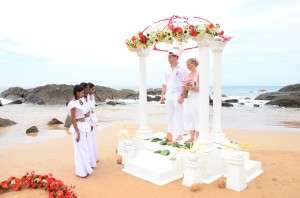 For a wedding amid stunning beaches, beautiful hill-top tea plantations, ancient cities and some of the friendliest people on earth. Sri Lanka, the tropical island at the toe of India, has a huge amount to offer: mystical ancient cities, thick jungles, tea plantations and mile upon mile of palm fringed sandy beaches. It is one of the most beautiful and scenically interesting islands in the world, and its enchanting and hospitable people are welcoming people back once more.
For a wedding amid stunning beaches, beautiful hill-top tea plantations, ancient cities and some of the friendliest people on earth. Sri Lanka, the tropical island at the toe of India, has a huge amount to offer: mystical ancient cities, thick jungles, tea plantations and mile upon mile of palm fringed sandy beaches. It is one of the most beautiful and scenically interesting islands in the world, and its enchanting and hospitable people are welcoming people back once more.
Sri Lanka, the tropical island at the toe of India, has a huge amount to offer: mystical ancient cities, thick jungles, tea plantations and mile upon mile of palm fringed sandy beaches. It is one of the most beautiful and scenically interesting islands in the world, and its enchanting and hospitable people are welcoming people back once more.
Sri Lanka is a leading wedding destination and one of the most sought after destinations for brides and grooms. The immense beauty of the island, along with its colonial past, over 2,000 years of ancient history, and the stunning beaches of the west coast are all attractions very few people manage to resist.
The gentle sounds of the waves of the Indian ocean and the heady fragrance of the tropical flowers will make for an enchanting ambience to say “I do”. Choose your own personalized vows or religious ceremony or have a traditional Sri Lankan wedding complete with drummers, dancers and an elephant with vows by a Kapuwa, a ceremonial wedding officiate.
Get married with the sun setting behind you over the Indian Ocean. Have a group of traditional drummers and dancers escort you to the wedding poruwa (platform). Enjoy a royal ride on an elephant where the surf breaks, right after you get married. If you like you can even dress in traditional Sri Lankan wedding attire and get married in traditional Sri Lankan style, with all the ancient rituals, blessings and customs.
An exotic setting adorned with fresh flowers, a traditional “poruwa”, a group of beautifully dressed young girls chanting traditional blessings, a conch shell blower, traditional Kandyan dancers and drummers, a tiered wedding cake, professional photographers and videographers to capture those cherished moments and even a majestic elephant are just some of the special arrangements we will make to create unforgettable memories of your wedding day.
Magnificent gardens and the bright tropical sun, endless beaches and brilliant blue hues of the Indian Ocean will provide a romantic backdrop for the most important day of your life.
Diverse locations are available and choice is yours, Hill country locations amidst the Tea Plantation, Beach, Jungle and many more…..
We can arrange the whole ceremony tailor-made to your exact requirements.
Wedding ceremony may includes:
-an exotic setting adorned with fresh flowers
-a traditional “poruwa” (platform)
-a Setty back
-a group of beautifully dressed young girls chanting traditional blessings,
-traditional conch shell blower
-traditional Kandyan dancers and drummers
-a tiered wedding cake
-a majestic elephant
-a Kapuwa, a ceremonial wedding officiate
-traditional Sri Lankan wedding attire (Saari)
-decorated car
-professional photographers and videographers
 All wedding ceremonies are carried out in accordance with British Law and are legally recognised as binding.
All wedding ceremonies are carried out in accordance with British Law and are legally recognised as binding.
For guests marrying in Sri Lanka, the wedding couple are required to arrive in Sri Lanka 5 days before the expected ceremony date.
The minimum legal age to marry in Sri Lanka is 18 years. Parental consent is required if under the age of 21 years.
For weddings in Sri Lanka the required documentation is as follows:
– Birth Certificates Copies can be mailed and originals to be presented on the day of the marriage.
– 10 year valid Passport photocopy to be mailed and the originals to be presented on the day of the marriage.
– A document detailing the names, addresses and the occupations of the bride & groom.
– A document detailing the names, addresses and the occupations of the Parents of the bride and groom.
– An affidavit (from a solicitor) confirming the marital status (i.e. single) of the bride and groom prior to the wedding.
– If divorced, a Decree Absolute
– If widowed, death certificate of former spouse
– If names have been changed, legal proof (signed by solicitor) is required.
A marriage certificate is supplied in English.
or a wedding with a difference choose Sri Lanka. As experts in organising weddings abroad, we can arrange for you to be escorted to the wedding ‘poruwa’ by a troupe of traditional drummers and dancers.
Magnificent gardens and the bright tropical sky, plus endless beaches and the brilliant azure hues of the Indian Ocean will provide the perfect romantic backdrop, whilst the inclusion of traditional music and clothing create an authentically Sri Lankan vibe ideal for those hoping to enjoy a wedding experience unlike that you would find in your country.
Choose your theme to make your big day a very special one!
- All
- Weddings



